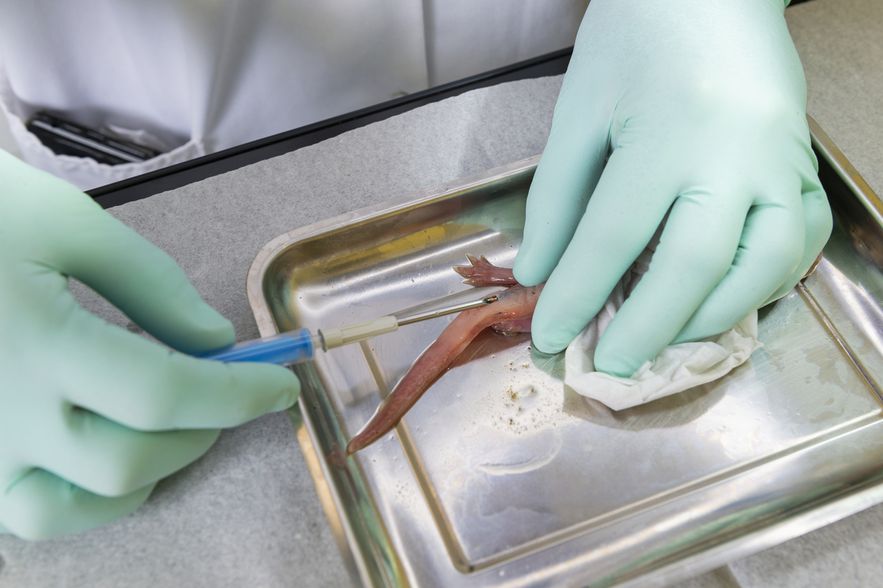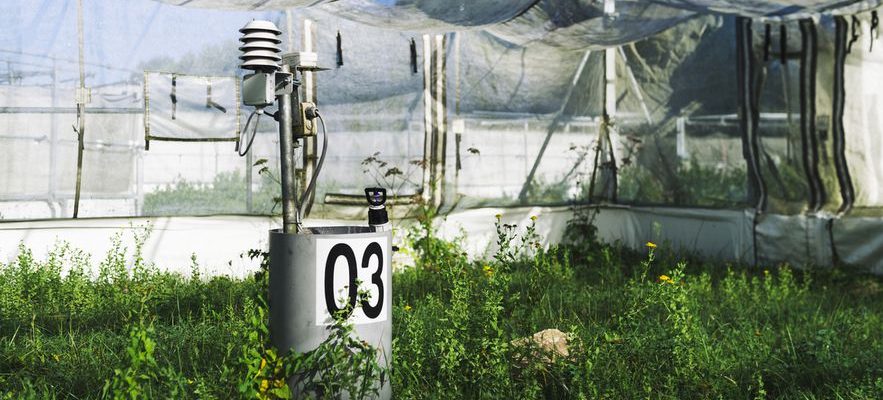They arrive in spring. Scientists by the dozen, in fleeces and boots. The elite of global ecology, coming from five continents. Everyone knows it in the industry: Moulis is the place to make a name for yourself in this now popular field. Isolated in the foothills of the Ariège Pyrenees, 40 kilometers from the motorway, this mountain village of 700 inhabitants is home to the largest experimental ecology station in the world. A little-known gem of French science.
Here, dozens of hectares of nature have been placed under cover, fenced in, enclosed, to simulate the heat waves and droughts of tomorrow, and to see how fish, lizards, insects and plants are coping. Even the mountain which overlooks the site belongs to the CNRS. In this 721 meter high Swiss cheese, biologists came to study – until 2000 – the proteas, strange albino cave salamanders. Research now abandoned due to more burning climate issues.
“No one had ever dared such a crazy project”
From the top of the peak, where an iron cross watches, it is impossible to miss this open-air laboratory: 200 blue tanks connected by transparent tubes, a greenhouse, an aviary, two administrative buildings, even a dormitory. Around twenty researchers stay there each season, from May to October, lulled by the mooing of the Béarnaises and the bell tower of the Romanesque church. A village within a village, with an ecology legend as its leader: Camille Parmesan, a 62-year-old Texan, Nobel Peace Prize winner in 2007 as a member of the IPCC.
The American is one of the signatories of Make Our Planet Great Again, Emmanuel Macron’s appeal launched in 2017 to recover those annoyed by Donald Trump’s climate skeptic turn. Not speaking French well enough, she allowed herself to be drawn into the Moulis adventure by her husband. An ecologist too, an inveterate Francophile, who came across one of the president’s videos by chance. The quality of the project, thought up first by Jean Clobert then Michel Loreau, two of the most renowned French biologists and former directors of the site, did the rest.
Camille Parmesan looks back on her beginnings with a smile. When the rock star of ecology lands in this France so deep that even the trains do not risk it – the line to Toulouse has been abandoned – the station is just taking off. Funding from the State and the Region has just been granted, the second since its creation in 2007. The first scientific work is only just beginning to be published. We had to tinker to make everything functional: “We started from nothing, no one had ever dared such a crazy project,” enthuses Julien Cote, biologist, and electrician, carpenter, carpenter or tailor, depending on the needs.
A climate modeled on the hypotheses of the IPCC
Around him, lizards wander, spread out in around forty 20 square meter enclosures made of mosquito nets and tarpaulins sunk into the ground. This is the Metatron, the terrestrial part of the site. By opening and closing the shutters of the cages to vary the temperature, the biologist realized that these reptiles would probably grow faster in a world at +1.5°C, or more. And surprise: under these conditions, they mate twice a year instead of once.
A few degrees more and the whole ecosystem falters. Excited lizards eat more spiders but die faster, while crickets thrive and devour grasses. Soil micro-organisms, these microscopic living beings which decompose plants, no longer develop in the same proportion, the composition of the earth changes. Such are the millions of upheavals caused by climate change. “There is never a positive impact, only imbalances,” specifies the researcher.
In these enclosures, researchers can vary the temperature using remotely controlled shutters.
© / Cyril FRESILLON / SETE / CNRS Images
Simon Blanchet takes care of the aquatic part of the site. Blue basins fed by water from the Lez, the valley’s river. The researcher controls the temperatures from a simple computer. Above the tanks, spiders have woven their webs, baited by the presence of insects. The “beeps” from the probes that measure oxygen and acidity did not bother them. Inside, plankton and algae develop, feeding the molluscs, which end up swallowed by the fish. At regular intervals, the specialist records, samples, examines and dissects.
These animals live as in 2050 with a daily climate modeled on the hypotheses of the IPCC. No more, no less: “There is no point in raising the temperature by 10 degrees, we know that they will not survive,” continues the scientist. Such experiments allow biologists to observe behavioral and genomic developments more closely than in nature. By controlling what comes in and what goes out, they more easily highlight certain interactions, and can compare the data with their theories.
Under these mosquito nets, researchers reproduce aquatic ecosystems and test the effects of global warming.
© / L’Express/Antoine Beau
Concerns, recognition and links with industry
As in a medical school, Moulis has its operating table for performing biopsies, an MRI machine and even a morgue. “We follow the same ethical rules as those who put electrodes in the heads of monkeys. When we can, we do without animals. Otherwise, we make sure to make them suffer as little as possible. A commission validates the acts which cause more pain than the prick of a needle,” explains Simon Blanchet.
Strangers, scalpels, tarpaulins, comings and goings in the mountains. Enough to feed the fantasies: “You cut off lizards’ fingers?”, grimaces a local child in front of Gladys Barragan-Jason. This scientist evaluates humans’ feeling of belonging to nature, the driving force behind more virtuous attitudes for the climate. A resident of the valley, visibly skeptical, asks: “Are we guinea pigs? Are the experiments dangerous?” In several out-of-the-way wading pools, researchers test agricultural and pharmaceutical toxins. But the doses are low, as in nature.

As in a medical school, Moulis has its operating table for performing biopsies, an MRI machine and even a morgue.
© / CNRS
Hikers were worried to see these “English” people returning from the preserved lakes of the Pyrenees with buckets full of trout – a catch for their experiments: “I want to make them a safety vest with CNRS flocking, so that we know that we don’t poach,” says Catherine Clerc, a former physics engineer who became administrative manager of the site. The fact remains that, overall, the inhabitants of the Couserans province are proud of their researchers. “It energizes you, otherwise you die,” whispers a retiree. A former cheesemaker agrees: “Plus, scientists love tomme.”
There are sometimes a few official visits, with great fanfare. But generally speaking, scientists interact little with politicians, despite their international aura. “We work with industry, with agencies like Ademe and administrations, rarely with elected officials,” regrets Simon Blanchet, whose research is partly financed by EDF. He is regularly surprised to see micro-hydroelectric power plant projects flourishing while the streams dry up. “This kind of infrastructure keeps rivers split, which prevents fish from reproducing.”
Camille Parmesan met Emmanuel Macron on several occasions. They dined, for example, at the launch of the French Biodiversity Office. What did they talk about? From the importance of finding compromises between environmental protection and the satisfaction of human needs, from the heaviness of French bureaucracy which also affects the world of research. The president listened, assures the scientist. Will he take it into account? That’s the whole question, asks Camille Parmesan. In ecology, experiments are spread over a period much longer than a five-year period.
.
